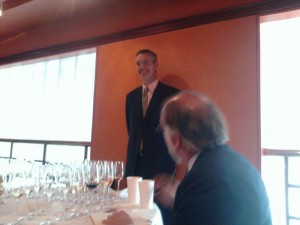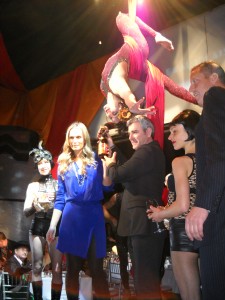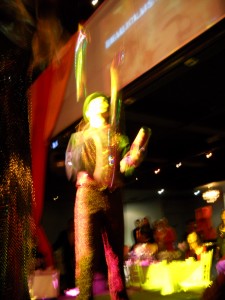 If you only drink rosé in the summer – challenge that! Sure, rosé wines are perfect summer sipping wines with their lighter body, refreshing acidity and affinity for being served at cooler temperatures. However, meatier rosés can make a wonderful addition to the dinner table year-round and will provide a rosy hue for your Valentine. And, France’s Tavel is a perfect example.
If you only drink rosé in the summer – challenge that! Sure, rosé wines are perfect summer sipping wines with their lighter body, refreshing acidity and affinity for being served at cooler temperatures. However, meatier rosés can make a wonderful addition to the dinner table year-round and will provide a rosy hue for your Valentine. And, France’s Tavel is a perfect example.
Produced from vines originally brought to the Rhône Valley by the Romans, Tavel was first made for the popes at Avignon as early as the 1300s. With its lighter body, low tannins and fruit driven character, the Popes enjoyed these wines, which became famous as the most red of all pink wines. After finding favor with the clergy, Tavel continued its long history, receiving official recognition as a controlled appellation in 1936, becoming the first AOC rosé wine in France.
With the iron-rich, clay and sandstone soils on the Rhône’s Left Bank more suitable for red wines, Tavel vines are grown on the Rhône’s Right Bank. Known for the wind-blown silts and sand that were deposited by the mistral after the ice age, these vineyards offer ideal conditions for fruit-forward, less-structured wines. Here, the soils are composed primarily of limestone, which formed millions of years ago when the area was initially under the sea. The land was eventually pushed to the surface where its mineral content provides acidity, minerality and aroma to today’s wines. Referred to as garrigue, which is also the name for the scrub vegetation that grows on it, these scents include lavender, thyme, rosemary.
Theoretically, Tavel may be made from a blend of up to 15 different grapes, most of which are red. Yet, in practice, the wines are limited to nine varieties and no grape can constitute more than 60% of the blend. These authorized grapes span from Roman (Bourboulenc) and Spanish (Grenache, Carignan and Mourvèdre) origin to French (Syrah, Cinsault, Calitor, Clairette, Picpoul) varieties, all of which thrive in the sun-drenched climate.
Crafted using the saignée method, the wines undergo an average of 12-48 hours during which the fresh grape juice is in contact with the red skins before being bled off. However, the soak may last up to 72 hours to pull significant tannins and color from the grape skins. Regardless of the time period, the wines are fermented at cool temperatures to preserve the intense aromatics.
The range of colors is determined by the combination of grape varieties, ripeness of the vintage (pH), temperature of the grapes at harvest, length of maceration and oxygen exposure. Moreover, the quickly oxidizing Grenache imbues the wines with more orange hues while high acid grapes add pinker tones. Finally, while Tavel has historically been known for its salmon hue, with the advent of modern technology, the wines are now more pink. And with the legal revisions made in 1997 that mandate the use of clear bottles, you’ll be able to admire the wine’s beautiful shade well before you pour it in your glass.
TASTING NOTES
Château d’Aqueria 2010, Tavel, Rhône Valley, France, $18.00
(52% Grenache, 12% Syrah, 11% Mourvèdre, 9% Clairette, 9% Cinsault, 6% Bourboulenc, 2% Picpoul)
This deep pink wine offers up aromas of cherries and berries. Its medium acidity and medium tannins provide nice structure for the darker red fruits, which pervade the palate.
Domaine de la Mordorée La Dame Rousse 2010, Tavel, Rhône Valley, France, $15.00
(56% Grenache, 20% Cinsault, 10% Clairette, 4% Syrah, 3% each – Mourvèdre, Bourboulenc and Grenache Blanc)
Medium pink in hue, this wine has aromas of berries, with some slight citrus pith and minerality, all of which persist on the palate. Vibrant acidity and light tannins result in a refreshing wine.
Domaine Maby la Forcadière 2010, Tavel, Rhône Valley, France, $20.00
(70% Grenache, 10% Cinsault, 10% Grenache Blanc, 10% Other)
Decidedly salmon in color, this wine shows floral and berry notes. The palate has medium acidity, low tannins and is dominated by fresh berry fruit flavors.
Prieuré de Montézargues 2010, Tavel, Rhône Valley, France, $19.00
(55% Grenache, 30% Cinsault, 13% Clairette, 2% Other)
Pale pink, with salmon highlights, berries and herbs greet the nose on this wine. Flavors of citrus and berries linger on the lively palate.
Château de Trinquevedel 2010, Tavel, Rhône Valley, France, $17.00
(60% Grenache, 15% Clairette, 10% Cinsault, 10% Syrah, 5% Bourboulenc)
With its medium pink appearance, this wine offers a range of floral, berry and herbal notes. Red berries and cherries are joined by a chalky/mineral character on the palate.




